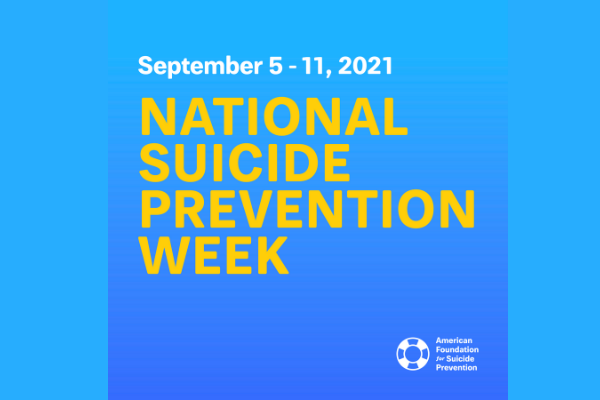By: Laura Handler
Highlights:
- As Director of Prevention Services at Region Ten Community Services Board, I know suicide is preventable and there are steps adults can take to help youth in crisis.
- It is important to recognize the warning signs that a young person may be experiencing thoughts of suicide.
- Next understand how to ask questions and listen nonjudgmentally to the response in order to seek further help and support that is available 24/7.

This week is National Suicide Prevention Week 2021 and is dedicated as a time to promote suicide prevention awareness and share resources. While it is not a topic most people prefer to discuss, suicide remains the second leading cause of death for youth ages 10-19 according to the Centers for Disease Control.[i] We do not yet fully know the impact of the COVID-19 pandemic on suicide rates, but there are indicators that emergency room visits for suspected suicide attempts among adolescents ages 12-17, particularly girls, have significantly increased.[ii]
Know the Warning Signs
Suicide is preventable and everyone can play a part in helping a young person. One of the most important ways teachers, parents, mentors, and other caring adults can support our youth is to recognize the warning signs that a young person may be having thoughts of suicide. Some of these warning signs include:
- Changes in eating and sleeping habits
- Loss of interest in usual activities
- Withdrawal from family or friends
- Feeling no reason for living, no sense of purpose in life
- Talking or writing about death, dying, or suicide
- Changes in appearance
- Giving away possessions
- Reporting thoughts of suicide that are active (i.e. “I want to die”) or passive (i.e. “I wish I could just fall asleep and not wake up”
- Seeking access to pills, weapons, and other means to kill themselves
- Increased substance use
What To Do Next
If you do notice warning signs, start by telling them that you are concerned and what you have noticed. Next, listen nonjudgmentally and ask open-ended questions to hear more about what the youth is experiencing. Hear them at their own pace and manage your own feelings of worry or concern. The next critical step is to ask the question
“Are you thinking about killing yourself?” or “Are you thinking about suicide?” It is best to avoid using a vague question such as “Are you thinking about hurting yourself?” because they may not know what you mean, or respond with a vague answer.
Be calm, specific, and direct because you want a direct answer.
Youth who are having thoughts of suicide often report a feeling of relief that someone noticed their pain and was willing to ask and hear more about it. If they are not thinking about suicide, your question will not “plant the idea in their mind.” For more tips on having the conversation, check out this resource from the American Foundation for Suicide Prevention (AFSP): “If Someone Tells You They’re Thinking About Suicide: A #RealConvo Guide from AFSP”
If a young person does report thoughts of suicide, it is important to connect them to professional help. There are many resources available locally and nationwide.
Specifically, I encourage everyone to put the National Suicide Prevention Lifeline (1-800-273-8255) and the Crisis Text Line (741741) into your phone’s contact list right now so you have the contact if you ever need it.
Both of these national resources are available 24 hours a day, seven days a week and have trained crisis counselors available to talk with you or the young person to help address these thoughts and develop a safety plan.
Ongoing additional support will also be important for a young person with current or recent thoughts of suicide. Reach out to their primary care doctor, a counselor, or other treatment professional who can more thoroughly assess what treatment or other supports might be most helpful.
While it can feel scary and anxiety-provoking to notice warning signs of suicide, it is important to ask the question, and get help. These steps can save a life. Showing the young person you care and are available for them when things are difficult is vital not only in moments of crisis, but every day.
References
[i] Deaths: Leading Causes for 2019. National Vital Statistics Report, Vol. 70, No. 9. https://www.cdc.gov/nchs/data/nvsr/nvsr70/nvsr70-09-tables-508.pdf
[ii] Yard, E., Radhakrishnan, L., Ballesteros, M.F., Sheppard, M., Gates, A., Stein, Z.,…Stone, D.M. (2021). Emergency Department Visits for Suspected Suicide Attempts Among Persons Aged 12-25 Years Before and During the COVID-19 Pandemic-United States, January 2019-May 2021. Morbidity and Mortality Weekly Report, 70, 888-894. Retrieved from: https://www.cdc.gov/mmwr/volumes/70/wr/mm7024e1.htm
If you have any comments or questions about this post, please email Youth-Nex@virginia.edu. Please visit the Youth-Nex Homepage for up to date information about the work happening at the center.

Author Bio: Laura Handler, LPC is the Director of Prevention Services at Region Ten Community Services Board. She has worked at the CSB for more than 12 years serving adults, youth, and families in the Charlottesville area. The Prevention Team offers trainings and presentations to support suicide prevention, substance use prevention, and promotion of mental health and wellness. If you are interested in learning more, please email prevention@regionten.org